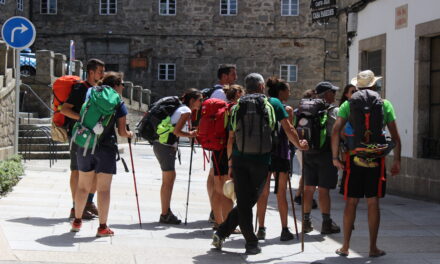Throughout the centuries, many pilgrims to Santiago have continued on their way to the sea, to the beaches and sanctuaries of Fisterra and Muxía. Many of them did so for the same reasons they visited Compostela, to make pilgrimages to holy places, to Christian shrines. But also many following ancient traditions and anthropological legends, which refer to these lands as the end of the world, the furthest western point of Europe, and as a place of worship and pagan rituals.
On the side of the cult and the Christian religion, these lands have historically been linked to the Marian cult, present in the sanctuaries of Santa María das Areas de Fisterra and the Virxen da Barca de Muxía. We are particularly interested in remembering that the Muxía shrine was closely linked to the Jacobean tradition because, following that of the Virgen del Pilar de Zaragoza, it would have been erected in a place where the Virgin had appeared to the Apostle Santiago. For its part, Santa Maria das Areas would have added to the great development that Marian shrines enjoyed during the fourteenth and fifteenth centuries, being particularly active throughout the sixteenth and seventeenth centuries.
Regarding pagan traditions and legends, Fisterra would be a land towards which many travelers and walkers would have gone in search of knowledge about life and death, following cults not only previous to Christianity, but even to before the arrival of the Romans . According to these traditions, Fisterra would have been the origin of numerous cults of life and fertility rituals, integrated by the Romans in their own religions as cults of the sun, but which disappeared with the arrival of Christianity.
The truth is that, from the great vitality of the Camino de Santiago, the development of the cult of the Virgin in the area and pagan traditions, Fisterra and Muxia became the destination of many pilgrims to Compostela, to the point of giving rise to new Jacobean legends.
Among the Compostela traditions linked to the area, we find particularly interesting those that link these coasts to the scallop shell of Santiago. The shell was sold as a symbol of a pilgrimage completed in the streets of Compostela since the time of Gelmírez, a tradition that begs a question that goes beyond discussions about Christian and pagan cults: Would not some pilgrims have preferred to continue on to the coast? and collect for themselves that symbol?
To the scallop-shell tradition, another ritual that still survives is added: the possibility of bathing in the beaches of Fisterra. This ritual is not at all secondary, reminding us of others linked to the end of Camino, such as washing in Lavacolla, already at the gates of Santiago. However, bathing in Fisterra, far from preparing the pilgrim for his encounter with Santiago, would refer us to a different symbolism, symbolism closely linked in Christianity to the shell: baptism. Bathing in the waters of Fisterra and obtaining a shell could certainly symbolize a new baptism, to which other traditions such as the burning or abandonment of old clothes or boots would have been added, all with a single message: to separate from the old to be able to give rise to a new beginning.
Photo: We have taken this image of the Commons Wikipedia project, its author is Gabriele form Rome.











